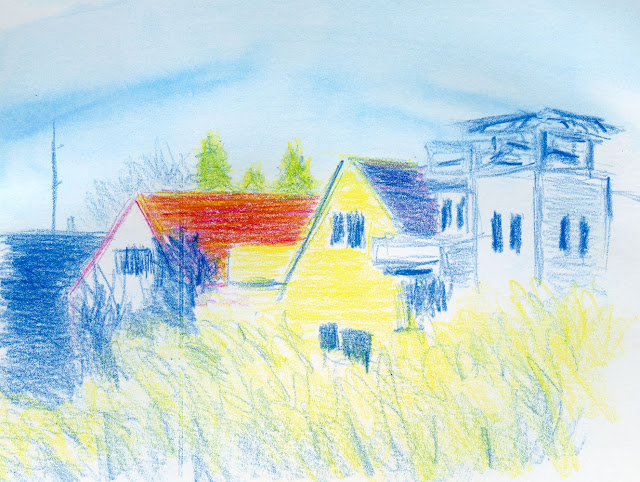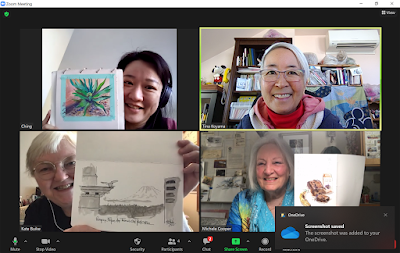 |
| 2/25/22 Caran d'Ache Neocolor I wax pastels in Stillman & Birn Zeta sketchbook |
As alluded to previously, a late-night retail therapy binge
led to buying several new-to-me art media. One was a small set of Caran d’Ache Neocolor I wax pastels. I’ve enjoyed using water-soluble Neocolor II crayons for years, especially when my primary art medium was collage, but
Neocolor I, which is Caran d’Ache’s non-soluble version of artist-quality crayons,
is new to me. They look like the crayons we used as kids, but unlike Crayolas,
Neocolor I contains rich pigment and applies with a less waxy feel.
I was inspired to try these crayons while reading Creative Drawing Techniques: From First Mark to Full Expression, a newly published book by David Brammeld. One of many media the author combines in his works, non-soluble Neocolor I acts as a resist when used with various wet media. He used the crayons mostly with watercolor in the examples he showed, but I figured they could be used with water-soluble pencils and markers, too.
Last week I invited a few friends to join me on Zoom for a mixed media play date to encourage myself to jump in. My first attempt above, which, I admit, doesn’t look very experimental, was nonetheless a novelty for me. I used the Neocolor I crayons to draw the familiar scene through my studio window. Then I spritzed the top half of the page generously with water and used my typical “licking” technique to take color from a Caran d’Ache Museum Aquarelle pencil tip and swipe it across the wet page. Normally, I would have to carefully avoid getting water on the water-soluble pencil work, but because I knew the crayons would resist water, it was easy to swipe liberally. In fact, I deliberately swiped the brush over the top part of the drawing to test the crayons’ resistance. I like the smooth, seamless sky that resulted.
 |
| Museum Aquarelle wash over Neocolor I scribbles |
I tried to take advantage of the optical mixing effect in the experiment below, which ended up messy. I used a yellow Neocolor as the base of the foliage at the bottom and left side of the sketch. On the right side of the lower foliage, I scribbled over the yellow Neocolor with a blue Museum Aquarelle pencil. On the left side, I scribbled over with a blue Faber-Castell Albrecht Dürer watercolor marker. Then I spritzed all the foliage areas with water. Since the yellow crayon didn’t activate with water, it couldn’t blend with the blue, but in areas where the blue was more transparent, the yellow shows through as green. The marker ink, however, was difficult to control and got a bit heavy. I do like how the insoluble crayon retained the paper’s texture. I need to practice this technique more if I’m going to use it effectively.
 |
| 2/27/22 Neocolors, Durer watercolor marker, Museum Aquarelle pencil in Stillman & Birn Beta sketchbook |
These crayons will require lots more play to figure out how I might use them on location, and play I will.
 |
| My mixed-media playmates Ching, Kate and Michele |
I like the results you got in the foliage on the left! I like your thinking.
ReplyDelete